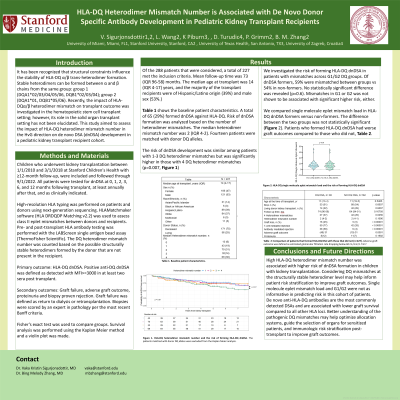Back

HLA-DQ Heterodimer Mismatch Number is Associated with De Novo Donor-Specific Antibody Development in Pediatric Kidney Transplant Recipients
(P415) HLA-DQ heterodimer mismatch number is associated with de novo donor-specific antibody development in pediatric kidney transplant recipients
Location: Platinum Ballroom


Melody Zhang, MD, A(ACHI)
Stanford University
Poster Presenter(s)
Aim: Structural constraints influence the stability of HLA-DQ α/β trans-heterodimer formation. Stable heterodimers can be formed between α and β chains from the same group: group 1 (DQA1*02/03/04/05/06, DQB1*02/03/04); group 2 (DQA1*01, DQB1*05/06). This study aimed to assess the impact of HLA-DQα/β heterodimer mismatch number in the HvG direction on de novo DSA (dnDSA) development in a pediatric kidney transplant recipient cohort.
Method: Children who underwent kidney transplantation between 1/1/2010 and 3/1/2018 at Stanford Children's Health with ≥12-month follow-up, were included and followed through 9/1/2022. All patients were tested for dnDSA at 0, 1, 2-, 3-, 6-, and 12 months following transplant, at least annually after that, and as clinically indicated. High-resolution HLA typing was performed on patients and donors using next-generation sequencing. Pre- and post-transplant HLA antibody testing was performed with single antigen bead-based IgG assay. The patients with dnDSA against DQ detected at >=1000 MFI in at least two post-transplant sera were considered as positive cases. The DQ heterodimer mismatch number was counted based on the possible structurally stable heterodimers formed by the donor that are not present in the recipient. Fisher’s exact test was used to compare groups. Survival analysis was performed using the Kaplan Meier method.
Results: A total of 228 patients were included. The median age was 13 (IQR 9), 25% had living donor transplant and 49% were female. The median follow-up time was 68 months (IQR 40) and 87 (38%) formed dnDSA against HLA-DQ. Fourteen patients were matched with donor DQ alleles and excluded from analysis; 214 patients were included. The risk of dnDSA development was similar among patients with 1-3 DQ heterodimer mismatches, but was significantly higher in those with 4 DQ heterodimer mismatches (p=0.007, Figure 1). The rate of dnDSA formation in patients mismatched across G1/G2 DQ groups was compared with those not across groups, but no statistically significant difference was revealed.
Conclusion: High HLA-DQ heterodimer mismatch number was associated with higher risk of dnDSA formation in children with kidney transplantation. Considering DQ mismatches at the structurally stable heterodimer level may help inform patient risk stratification to improve graft outcomes.
Method: Children who underwent kidney transplantation between 1/1/2010 and 3/1/2018 at Stanford Children's Health with ≥12-month follow-up, were included and followed through 9/1/2022. All patients were tested for dnDSA at 0, 1, 2-, 3-, 6-, and 12 months following transplant, at least annually after that, and as clinically indicated. High-resolution HLA typing was performed on patients and donors using next-generation sequencing. Pre- and post-transplant HLA antibody testing was performed with single antigen bead-based IgG assay. The patients with dnDSA against DQ detected at >=1000 MFI in at least two post-transplant sera were considered as positive cases. The DQ heterodimer mismatch number was counted based on the possible structurally stable heterodimers formed by the donor that are not present in the recipient. Fisher’s exact test was used to compare groups. Survival analysis was performed using the Kaplan Meier method.
Results: A total of 228 patients were included. The median age was 13 (IQR 9), 25% had living donor transplant and 49% were female. The median follow-up time was 68 months (IQR 40) and 87 (38%) formed dnDSA against HLA-DQ. Fourteen patients were matched with donor DQ alleles and excluded from analysis; 214 patients were included. The risk of dnDSA development was similar among patients with 1-3 DQ heterodimer mismatches, but was significantly higher in those with 4 DQ heterodimer mismatches (p=0.007, Figure 1). The rate of dnDSA formation in patients mismatched across G1/G2 DQ groups was compared with those not across groups, but no statistically significant difference was revealed.
Conclusion: High HLA-DQ heterodimer mismatch number was associated with higher risk of dnDSA formation in children with kidney transplantation. Considering DQ mismatches at the structurally stable heterodimer level may help inform patient risk stratification to improve graft outcomes.
